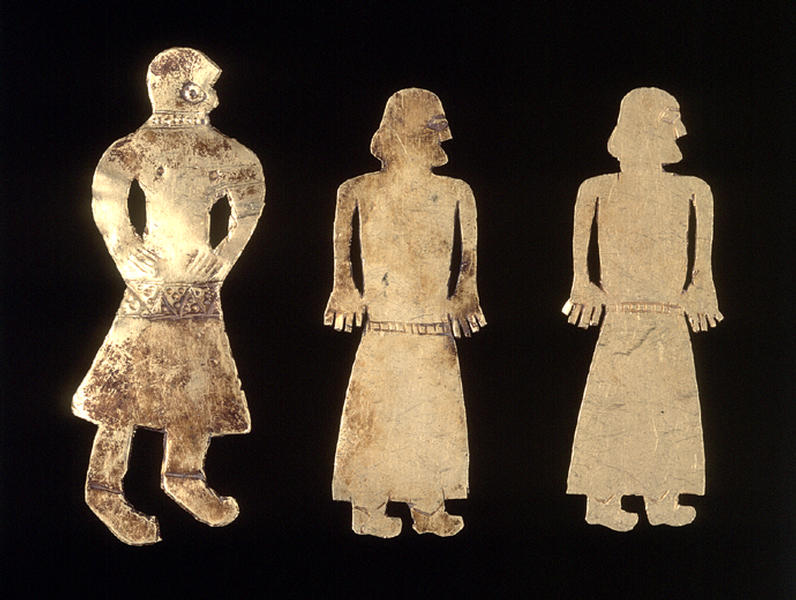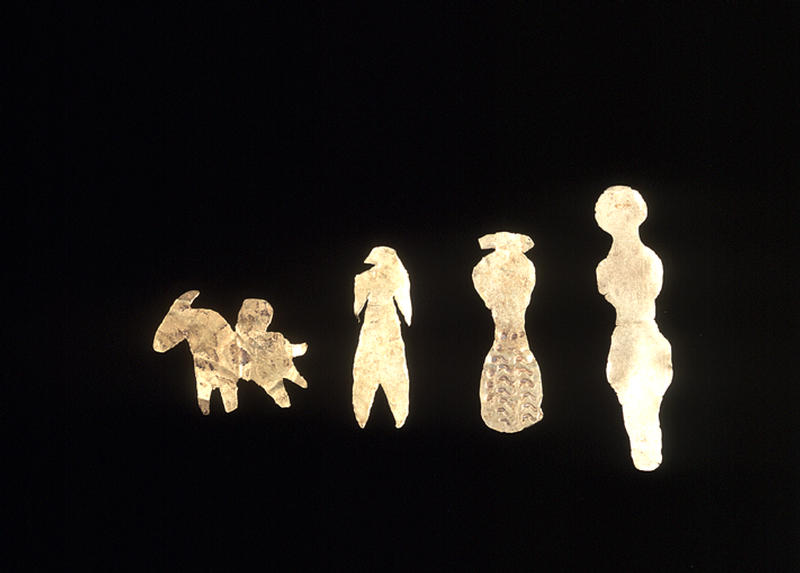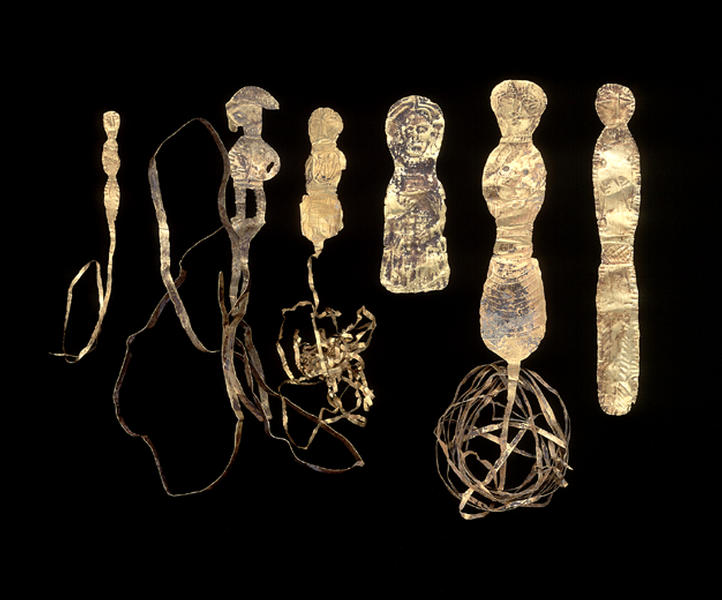奉納板
- 紀元前5-紀元前2世紀
- 金
解説(古代バクトリア遺宝展)
前5―前2世紀
金
a:高5.5 cm 幅1.9 cm b:高5.0 cm 幅1.8 cm c:高5.0 cm 幅1.8 cm
d:高1.9 cm 幅1.2 cm e:高2.1 cm 幅0.7 cm f:高2.4 cm 幅0.8 cm
g:高3.3 cm 幅0.8 cm h:高3.6 cm 幅0.6 cm i:高4.6 cm 幅1.7 cm
j:高4.1 cm 幅1.5 cm k:高6.2 cm 幅2.2 cm l:高8.7 cm 幅2.1 cm
m:高10.0 cm 幅1.5 cm
金板を切り抜き、人物あるいは動物をシルエットで表している。
Aは両手を腰に当て膝丈のチュニックを着けた男性の形に金板を切り抜き、片側に眼、首飾、乳頭、手、ベルトを刻み右向きの姿を表している。眼は小円に刻点で表し、首飾は刻点で、ベルトは三角形の連続帯と刻点で装飾されている。
Bとcは2枚とも殆ど同じ形状の踝まで届く長い衣服を着た男性形を切り抜き、両面に眼、手、ベルト、靴を刻んでいる。
Dは金板の切り抜きで驢馬が荷を背負っている姿あるいは騎馬の人物を表現している。騎馬の人物は首が失われている。
E~gは人物の形状に金板を切り抜いている。Fはその下部を波形の刻印と点刻で装飾している。
iは金板を左向きの神官の姿の下に長いバンドが伸びる形に切り抜いている。神官は両手を腰にあて、キュルバシスを被り、短いチュニックを着け、ズボンと短い靴を履いている。乳頭、首飾とズボンに点刻を施し、袖の皺を線刻で表している。
Hとj~mは正面向きの人物を概ね頭部、胴部、下半身の三つの膨らみをもった形状で表している。H、j、lは下にバンドが伸びている。H、j、l、mは乳頭を点刻で表し、両手を胸にあてている。Jとlは足が線刻されている。
Catalogue Entry
5th‐2nd century B.C.
Gold
(a)H. 5.5 cm, W. 1.9 cm(b)H. 5.0 cm, W. 1.8 cm
cH. 5.0 cm, W. 1.8 cm(d)H. 1.9 cm, W. 1.2 cm
(e)H. 2.1 cm, W. 0.7 cm(f)H. 2.4 cm, W. 0.8 cm
(g)H. 3.3 cm, W. 0.8 cm(h)H. 3.6 cm, W. 0.6 cm
(i)H. 4.6 cm, W. 1.7 cm(j)H. 4.1 cm, W. 1.5 cm
(k)H. 6.2 cm, W. 2.2 cm(l)H. 8.7 cm, W. 2.1 cm
(m)H. 10.0 cm, W. 1.5 cm
These are silhouettes of human or animal figures cut from gold sheets.
Figure a shows a male wearing a knee-length tunic, with both hands at his hips. The figure faces to the right and one eye, the necklace, nipple, hand, and belt are incised on the figure. The eye is pressed with a small circle, and the necklace is similarly dotted, while the belt is shown as a linked triangular design and dotted.
Figures b and c are essentially the same shape and show a male figure wearing a garment that hangs to his heels. Both eyes, hands, belt, and shoes are incised.
Figure d shows either a donkey with baggage on his back, or a rider on a horse. The figure of the rider is missing from neck up.
Figures e through g are human shapes cut from gold sheets. Figure f has its lower section decorated with incised and stamped designs.
Figure I shows a figure of a priest cut from a sheet of gold. He is facing to the left and a band extends from the bottom end of the plaque. The priest has both hands at his hips, he wears a kyrbsia headgear, a short tunic, trousers and short boots. The nipple, necklace and trousers are dotted, while the wrinkles on his sleeves are linear incisions.
Figures h and j through m all are human figures facing forward, with their heads, torsos and lower bodies shown as three swelling forms. Figures h, j, and l have bands extending from the bottom. Figures h, j, l, and m have their nipples shown by dotting, and both arms at their chests. Figures j and l have their feet depicted in linear incisions.


